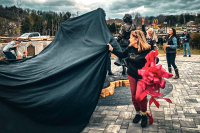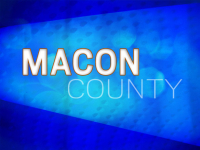Drum, song and dance highlight Powwow
 With strong personal, familial and spiritual traditions and a healthy dose of competition, the 37th annual Cherokee Powwow will ignite a three-day festival of drum, song and dance to kick off the summer season in Cherokee.
With strong personal, familial and spiritual traditions and a healthy dose of competition, the 37th annual Cherokee Powwow will ignite a three-day festival of drum, song and dance to kick off the summer season in Cherokee.
Hundreds of powwow dancers, including several world champions, will compete at the Acquoni Expo Center June 29-July 1.
“Powwows are hugely popular social gatherings within Native communities that feature authentic Indian competitive dancing, drumming and tribal regalia,” said Robert Jumper, tourism manager for the Eastern Band of Cherokee Indians.
A powwow is a fun social event and family reunion. At the same time, it provides a setting for spiritual enrichment through traditional rituals and individual reflection. They also reinforce the values of working together as a family and bonding as a community.
The powwow drum, which is played throughout the event, carries the heartbeat of the Indian nation and Mother Earth. As with many things in the Indian culture, the drum is used to bring balance and rejuvenation to a person through their participation in dancing, singing or listening to the beat.
Related Items
The drum is a large base covered with buffalo, deer or cowhide. Forming a circle, eight or more men strike the drum in unison with covered mallets. The men then blend their voices with the beating of the drum to create the song. The songs are often in the Indian language of the drum members. Some are traditional and passed down through history; others are contemporary and created to speak to current concerns and interests.
All powwows begin with the grand entry. Flags and eagle staffs of the host and visiting tribes are brought into the arena. The staffs and flags represent nations, families and communities. As the drums begin a grand entry song, the chief and visiting dignitaries enter the arena. They are followed by other honored members and the color guard of veterans. Then, the dancers enter in a specific order: men, women, teenage boys, teenage girls, younger boy, younger girls and finally the tots. The arena is filled with all of the dancers, each dancing in their grand regalia.
“Visitors to Cherokee’s powwow will experience a colorful expression of energy and reverence as people of all ages from across the country gather to watch and participate. It’s a sight to behold, and there’s nothing like it in North Carolina,” Jumper said.
Craft vendors from across the country will offer of a variety of handmade items. On-site food vendors will sale food, including burgers, fry bread, meat pies, roasted corn and snow cones. There is plenty of free parking and stadium seating, and visitors are encouraged to bring a lawn chair. Coolers and pets are not permitted.
During the two-hour dinner break for the dancers on Saturday evening, Cherokee entertainers will perform flute music, traditional dancing and storytelling.
Experience the Powwow firsthand
The Acquoni Expo Center will host a powwow June 29-July 1. Gates open at 5 p.m. June 29 and at noon the following two days. The grand entry ceremonies are at 7 p.m. Friday, 1 p.m. and 7 p.m. Saturday, and 1 p.m. Sunday.
Friday and Sunday admission is $5 per person; Saturday is $10, but children under 6 get in free.
The Acquoni Expo Center is located at 1501 Acquoni Road in Cherokee.
800.438.1601 or visit www.cherokee-nc.com.
The Dances
The dances at powwows have strong personal and spiritual backgrounds. There are many different stories and interpretations for each dance depending on tribal and family background. Each category of dance has a specific style of song and pace. The drum group is responsible for having whatever style of song is required available upon request.
Men’s Traditional Dance
This is the oldest form of dance in the Indian culture. The movements tell of warriors hunting and stalking game and battling an enemy. The regalia often represent animals and reflect a personal expression of creativity and artistry.
Women’s Traditional Dance
This dance requires enormous stamina, concentration and grace. Women move their feet in time with the drum, keeping them close to the ground. As the drum plays “honor beats,” women raise their fans to honor the drum and their male relatives.
Men’s Grass Dance
One tale says the grass dance comes from the movements of the early scouts. The grass was high in new areas, and the scouts would dance in a special way to flatten the grass, making it acceptable for a new camp or meeting site. The dance also reflects warrior movements such as stalking game or an enemy and fighting an enemy.
Women’s Jingle Dress
The Ojibwe people first introduced this dance. As the story goes, a medicine man’s granddaughter was very ill. He had a dream in which a spirit wearing the jingle dress came to him and told him to make one of the dresses and put it on his granddaughter to cure her. When he awoke, he and his wife assembled the dress, and when finished, they brought his granddaughter to the dance hall, and she put on the dress.
Men’s Fancy Dance
One of the more modern dances in the powwow, Men’s Fancy dance is the most strenuous and athletic. The dance is fast and features jumps and twirling. The regalia are said to represent the rainbow spirits with its bright colors and flying feathers and ribbons. The Men’s Fancy dancer typically wears two bustles of bright-colored feathers with added ribbon, feather or horsehair hackles, and bright arm and headbands. The dancer also wears a headdress roach trimmed in colored horsehair and featuring two eagle feathers.
Women’s Fancy Shawl Dance
This is the most modern of the women’s dances. The dance is extremely athletic and strenuous, involving kicks and twirls and fast movements similar to the Men’s Fancy Dance in speed and style.









